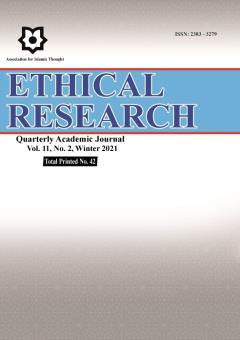Transparency Indices and Anti-Corruption Criteria and the Impact of International Assessment and Standards
Subject Areas : Ethics and Islamic Educationhamid rahimi 1 , saber niyavarani 2 * , Mohammad jalali 3 , Assadollah Yavari 4
1 -
2 -
3 -
4 -
Keywords: Transparency and Anti-Corruption, Indices International Standards, World Bank, Transparency International.,
Abstract :
Transparency and anti-corruption indicators are a way to deal with corruption in the government and ruling classes and have different categories. Corruption has created obstacles in advancing the goals and development of countries. Although there have been effective efforts to create an index of transparency and the fight against corruption, there is no satisfactory answer to this problem, and many developing countries continue to suffer from corruption at all levels. The most important divisions of transparency and anti-corruption indicators are presented in two forms: polls and evaluations.
عادل، آذر؛ مریم، امیرخانی ،«سیاهچالههای بودجه در نظام بودجهریزی ایران»، مجله مدیریت دولتی
(دانشگاه تهران)، شماره 4، 1395، 257.
مقیمی، محمد؛ علی اصغر، پور عزت، حسن، دانایی فرد؛ حیدر، احمدی، «طراحی و تبیین مدل بودجهبندی بر اساس شاخصهای حکمرانی خوب در ایران»، مجله مدیریت دولتی (دانشگاه تهران) 4، 1395، 647.
قضاوی، حسین ،«نگاهی به شاخصههای سنجش مبارزه با فساد»، مجله اقتصادی سال پنجم شماره های 51 و 25، 1383.
Ades, A. & R. Di Tella, “National Champions and Corruption: Some Unpleasant Interventionist Arithmetic”, The Economic Journal, CVII, 1023-1042. 1997.
David, Cabedo, “Improving and measuring transparency in NGOs: A disclosure index for activities and projects”, Nonprofit Leadership and management, 33, 2017, 331.
Davis, K. E., & Kingsbury, B. “Indicators as interventions: pitfalls and prospects in supporting development initiatives” (pp. 1–55). Rockefeller Foundation. 2011.
Fisman, R. & R. Gatti, “Decentralization and Corruption: Cross-Country and Cross-State Evidence” Unpublished Manuscript, World Bank, Washington D.C. .9991
IDS. “An Upside-down View of Governance. Brighton”, UK: Institute for Development Studies. 2010.
Lambsdorff, J. G. “The Institutional Economics of Corruption and Reform”. Cambridge University Press. 2007.
Nieves, Zangia, “Land Corruption Topic Guide”, Third edition, 2018,12.
OECD. “OECD Glossary of Statistical Terms”. OECD Publishing. 2008.
Theodore, Kahn, “Digital Technologies for Transparency in Public Investment: New Tools to Empower Citizens and Governments”, First Edition, 2018,14.
United Nations. “United Nations Handbook on Practical Anti-Corruption Measures for Prosecutors and Investigators”. United Nations. 2004.
World Bank. “Strengthening World Bank Group Engagement on Governance and Anticorruption”. Washington, DC: World Bank. 2007.
Alesina, A. and B. Weder, “Do Corrupt Governments receive less Foreign Aid?” American Economic Association. 2002.
Cooray, Arusha, “Transparency Pays? Evaluating the Effects of the Freedom of Information Laws on Perceived Government Corruption”, journal Of Development Studies , 53, 2017, 118.
Glaeser, E., La Porta, F. Lopez-de Silanes and A. Shleifer, “Do Institutions Cause Growth?”, Journal of Economic Growth, V9(I3): PP271-303. 2004.
Grimmeli, khuijsen, “Do Freedom of Information laws increase transparency of government? A replication of a field experiment”, journal of Behavioral Public Administration, 2, 2018, 10.
Johnson, Simon & James A. Robinson. “The Colonial Origins of Comparative Development: An Empirical Investigation.” The American Economic Review 91(5):1369-1401. 2001.
Lambsdorff, J.G., “Background Paper to the 2004 Corruption Perceptions Index”, Framework Document, Transparency International and the University of Passau. 2004.
La Porta, R., F. Lopez-De-Silanes, A. Shleifer and R.W. Vishny, “Trust in Large Organisations.” The American Economic Review, Papers and Proceedings, CXXXVII (2), 333-.8 .7991
McArthur, John W., & Sachs, Jeffrey D. “Institutions and Geography: Comment on Acemoglu, Johnson and Robinson” NBER Working Paper No. 8114, February 2.100
Mallick, Sushanta, “Does Institutional Linkage of Bank-MFI Foster Inclusive Financial Development Even in the Presence of MFI Frauds?”, scottish Journal Of Political Economy , 64, 2017, .482
Mauro, P. “Corruption and Growth”, Quarterly Journal of Economics, CX, 681–712. 1995.
Rijckeghem, C. Van & Weder, B. “Corruption and the Rate of Temptation: Do Low Wages in the Civil Service Cause Corruption?”, International Monetary Fund Working Paper, 97/73. 1997.
Svensson, J. and R. Reinikka, “Survey Techniques to Measure and Explain Corruption,” World Bank Policy Research, working paper No 3071. 2003.
Transparency International (b). “Corruption Perception Index 2012”: Short Methodology Note. Available at: http://www.transparency.org/files/content/pressrelease/2012_CPIUpdatedMethodology_E MBARGO_EN.pdf. 2012.
WGI, “Worldwilde Governance Indicators”. Frequently Asked Questions. Availabe at: http://info.worldbank.org/governance/wgi/faq.htm. 2013.

